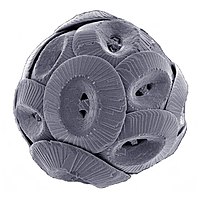
Photo from wikipedia
Compared to plankton, benthic communities are thought to be heterogeneous among sites and more stable through time; however, benthic protists in general, and sand-dwelling dinoflagellates in particular, have been scarcely… Click to show full abstract
Compared to plankton, benthic communities are thought to be heterogeneous among sites and more stable through time; however, benthic protists in general, and sand-dwelling dinoflagellates in particular, have been scarcely studied, and their diversity remains mostly unknown. To test those claims, we studied the diversity, structure and temporal dynamics of benthic dinoflagellate communities in sandy sediments obtained from 3 NW Mediterranean Sea coastal locations during temperate spring and warm summer months. After separating protist cells from the substrate using the seawater-ice method, high-throughput amplicon sequencing of the V4 18S rRNA gene region followed by the analysis of amplicon sequence variants (ASVs) showed similar richness, alpha-diversity, and community composition among sand-dwelling dinoflagellates at the 3 locations. Dinoflagellates affiliating with the Thoracosphaeraceae or Gymnodiniales sensu stricto were highly represented. In contrast, other well-known dinoflagellate taxa, such as Gonyaulacales or Dinophysales, were poorly represented or absent. Dinoflagellate communities showed significant differences between the 2 studied seasons, mainly driven by water temperature. Samples from temperate months had higher diversity and were more dissimilar, while samples from warmer months showed lower diversity and higher similarity. Some species were always present in the community, others only appeared sporadically, and some others showed clear differences between seasons. Our results suggest that large-scale changes (pointing to seasonality) prevail over spatial heterogeneity in shaping community composition. The 3 studied locations had a similar dinoflagellate community composed of sand-dwelling taxa, with many representatives of undescribed species, highlighting the need to further study the diversity of the benthic compartment.
Journal Title: Aquatic Microbial Ecology
Year Published: 2021
Link to full text (if available)
Share on Social Media: Sign Up to like & get
recommendations!